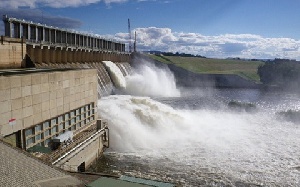 Perennial flooding and its related destructions have caused the spillage of the Bagre Dam
Perennial flooding and its related destructions have caused the spillage of the Bagre Dam
Government has planned to carry out an urgent exercise at an estimated cost of GH¢29.6 million, aimed at providing long-term solution to the perennial flooding and its related destructions caused by the spillage of the Bagre Dam, the Water Resources Commission has hinted.
In a statement by the Commission issued to Ghanaian Times on Sunday, the Executive Secretary, Ben Ampomah said, “government wishes to assure the public that, it is committed and is working on short and long term measures to mitigate the impacts of the perennial floods in the White Volta Basin.”
The exercise, according to the Commission, would include the dredging of the White Volta in the upstream areas of Yarugu (Bawku), Pwalugu, and the confluence of the Sissili and Kulpawn tributaries, which would cover an expected area of about 30km.
In addition, 42 communities comprised of 25 in Bawku West, five in Nabdam and 12 in Talensi, all in the Upper East Region, would be engaged to ensure that the causes of the floods and the attendant damages are reduced, Mr Ampomah said.
He explained that there would be documentary production for awareness creation on restoration and stabilisation of dredged river banks, and emergency response.
Mr Ampomah indicated that the exercise would be done to compliment the ongoing non-structural measures, notably, the provision of forecast and early warning information.
Other measures, in this regard, include the exchange of data and information on the spills, consultations with managers of the Bagre Dam, community education, awareness creation, and emergency response.
He explained that the exercise would minimise the impacts of flooding in the upstream of the main White Volta within the Yarugu, Pwalugu, and the confluence of the tributaries.
Additionally, the dredging, he noted, would improve flows into the Pwalugu Dam, and facilitate flow from the Sissili and Kulpawn tributaries, and, also minimise sedimentation of the Pwalugu reservoir.
According to Mr Ampomah, the results of an initial interventions carried out in 2019, has proved that dredging of the White Volta river, when done periodically as a maintenance activity would yield greater positive impact.
“At the end of the rainy season in November 2019 there were no reports of extensive flooding of the dredged areas potentially prone to flooding in the past. The destruction of crops and farmlands also reduced significantly in the area,” he said.
To date, several farmlands within the upstream sections of the White Volta, especially, the Bawku Municipal, Bawku West, Talensi and Nabdam districts have been flooded through the spillage of the Bagre Dam.
This situation, the Commission acknowledges, should it prevail in September and November 2020, would affect lives, settlements and human health, while, the financial costs of relief and emergency responses would be colossal.
Already, six people have died as a result of flood from the spillage of Bagre dam in the North East Region, a situation which was compounded with heavy rains in the area in the past few weeks, destroying several acres of farmlands, and left hundreds homeless.
The spillage of the Bagre Dam has become an annual ritual, with the Water Resource Commission, indicating that this year’s opening of spill gates and release of water from the dam has become the earliest, since 2007.